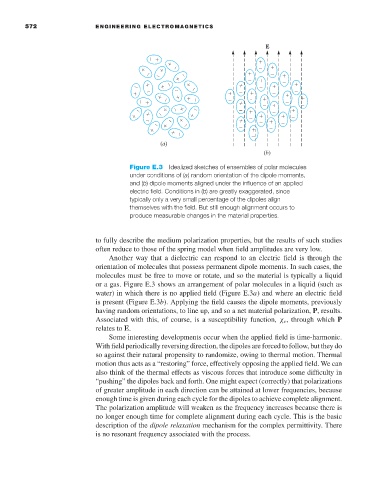Page 590 - Engineering Electromagnetics, 8th Edition
P. 590
572 ENGINEERING ELECTROMAGNETICS
Figure E.3 Idealized sketches of ensembles of polar molecules
under conditions of (a) random orientation of the dipole moments,
and (b) dipole moments aligned under the influence of an applied
electric field. Conditions in (b)are greatly exaggerated, since
typically only a very small percentage of the dipoles align
themselves with the field. But still enough alignment occurs to
produce measurable changes in the material properties.
to fully describe the medium polarization properties, but the results of such studies
often reduce to those of the spring model when field amplitudes are very low.
Another way that a dielectric can respond to an electric field is through the
orientation of molecules that possess permanent dipole moments. In such cases, the
molecules must be free to move or rotate, and so the material is typically a liquid
or a gas. Figure E.3 shows an arrangement of polar molecules in a liquid (such as
water) in which there is no applied field (Figure E.3a) and where an electric field
is present (Figure E.3b). Applying the field causes the dipole moments, previously
having random orientations, to line up, and so a net material polarization, P, results.
Associated with this, of course, is a susceptibility function, χ e , through which P
relates to E.
Some interesting developments occur when the applied field is time-harmonic.
With field periodically reversing direction, the dipoles are forced to follow, but they do
so against their natural propensity to randomize, owing to thermal motion. Thermal
motion thus acts as a “restoring” force, effectively opposing the applied field. We can
also think of the thermal effects as viscous forces that introduce some difficulty in
“pushing” the dipoles back and forth. One might expect (correctly) that polarizations
of greater amplitude in each direction can be attained at lower frequencies, because
enough time is given during each cycle for the dipoles to achieve complete alignment.
The polarization amplitude will weaken as the frequency increases because there is
no longer enough time for complete alignment during each cycle. This is the basic
description of the dipole relaxation mechanism for the complex permittivity. There
is no resonant frequency associated with the process.

